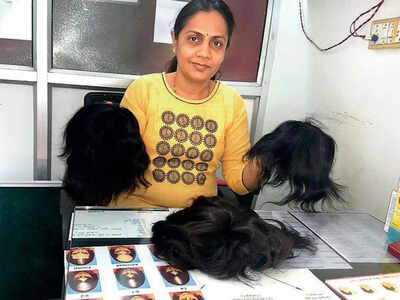
There’s hair transplantation for those who cannot embrace their baldness easily. But for those unwilling to undergo such surgeries, there’s always the wig. The hairpiece has brought solace to alopecia and chemotherapy patients alike and much cheer to the Kardashians and Lady Gagas donning them on those big nights out. In fact, celebrities are seen as having normalized the wearing of wigs in recent years.
The first known wigs were made of human hair in Egypt way back in 2700 BC, says skin-care specialist Vrushali Maisekar. In the 17th and 18th centuries, large full-bottomed expensive wigs signified the wealth of an individual. Hair was harvested from the heads of the rural working class.
Interestingly, the tonsure shops at the Tirupati temple are today the biggest suppliers of human hair world-wide. Maisekar says that while some Indian wig-makers buy the hair during the auctions at the temple, most of it is sent abroad for a chemical treatment mainly to remove the cuticles.
Maisekar gets readymade wigs of both human and synthetic hair from foreign countries. Her Indian-made wigs usually come out of factories in Kolkata, some places in the south of the country and Mumbai, she says. She sends the specifications required for her clients to these factories and gets her wigs prepared within 10 days.
Full wigs for women are usually made in Indian factories only and can cost up to Rs 25,000. Human hair wigs are pricier and last longer than the synthetic ones, but 18 months is usually the time by which one needs to buy a new wig, she says.
The wigs are made by sewing hair strands individually or in bunches into a lace base made of polyurethane and nylon. Highly advanced bases these days offer a natural-looking frontline and hairline, says Maisekar. Once she gets a wig from the factory, it requires a little styling and customization to suit the wearer.
Maisekar sells around 30 partial and full wigs each month with the start price being Rs 5,000. Around half her clients are chemotherapy patients.
Another wig seller, Namrata Pawar, has been in the trade for the past two years. Of the 15-odd wigs she sells each month, at least six are made locally by her workforce.
A full wig for women would use 5-10 lakh strands of hair which are at least 30 inches long, says Pawar. She buys hair of such length for around Rs 50,000 a kilo. The wigs made at her workshop get an application of shampoo, conditioner, gel and serum to give it a natural gloss. She advises her buyers to also wash, shampoo and condition their wigs two or three times a month. Among styles in wigs, the preference is for the Indian wavy look, not curls or straight hair, she says.
Most wigs lose their sheen and do not appear natural after two years, says Pawar. Chemotherapy patients need wigs for around that much time; their own natural hair starts growing again thereafter.
Maisekar says wigs today have shed the artificial look and feel of the past. The chemical treatment of hair in the factories is much advanced these days, she points out. Earlier, the entire base of the wig would be stuck to the head, which was rather uncomfortable for the wearer. Today, only an outer ring of the base is fixed to the head and the fitting is such that even an intense dust storm would not knock off the hairpiece, she says.
That’s literally keeping your hair on in all circumstances, like Angelina Jolie did even while wearing an array of wigs in the 2009 flick ‘Salt’.
The first known wigs were made of human hair in Egypt way back in 2700 BC, says skin-care specialist Vrushali Maisekar. In the 17th and 18th centuries, large full-bottomed expensive wigs signified the wealth of an individual. Hair was harvested from the heads of the rural working class.
Interestingly, the tonsure shops at the Tirupati temple are today the biggest suppliers of human hair world-wide. Maisekar says that while some Indian wig-makers buy the hair during the auctions at the temple, most of it is sent abroad for a chemical treatment mainly to remove the cuticles.
Maisekar gets readymade wigs of both human and synthetic hair from foreign countries. Her Indian-made wigs usually come out of factories in Kolkata, some places in the south of the country and Mumbai, she says. She sends the specifications required for her clients to these factories and gets her wigs prepared within 10 days.
Full wigs for women are usually made in Indian factories only and can cost up to Rs 25,000. Human hair wigs are pricier and last longer than the synthetic ones, but 18 months is usually the time by which one needs to buy a new wig, she says.
The wigs are made by sewing hair strands individually or in bunches into a lace base made of polyurethane and nylon. Highly advanced bases these days offer a natural-looking frontline and hairline, says Maisekar. Once she gets a wig from the factory, it requires a little styling and customization to suit the wearer.
Maisekar sells around 30 partial and full wigs each month with the start price being Rs 5,000. Around half her clients are chemotherapy patients.
Another wig seller, Namrata Pawar, has been in the trade for the past two years. Of the 15-odd wigs she sells each month, at least six are made locally by her workforce.
A full wig for women would use 5-10 lakh strands of hair which are at least 30 inches long, says Pawar. She buys hair of such length for around Rs 50,000 a kilo. The wigs made at her workshop get an application of shampoo, conditioner, gel and serum to give it a natural gloss. She advises her buyers to also wash, shampoo and condition their wigs two or three times a month. Among styles in wigs, the preference is for the Indian wavy look, not curls or straight hair, she says.
Most wigs lose their sheen and do not appear natural after two years, says Pawar. Chemotherapy patients need wigs for around that much time; their own natural hair starts growing again thereafter.
Maisekar says wigs today have shed the artificial look and feel of the past. The chemical treatment of hair in the factories is much advanced these days, she points out. Earlier, the entire base of the wig would be stuck to the head, which was rather uncomfortable for the wearer. Today, only an outer ring of the base is fixed to the head and the fitting is such that even an intense dust storm would not knock off the hairpiece, she says.
That’s literally keeping your hair on in all circumstances, like Angelina Jolie did even while wearing an array of wigs in the 2009 flick ‘Salt’.
Coronavirus outbreak
Trending Topics
LATEST VIDEOS
City
 Covid-19 news: UK national tests +ve; all 289 offloaded at Kochi airport
Covid-19 news: UK national tests +ve; all 289 offloaded at Kochi airport  Congress workers who put up posters shaming prominent UP BJP leaders arrested
Congress workers who put up posters shaming prominent UP BJP leaders arrested  Coronavirus: 218 Indians evacuated from Italy, land in Delhi, will be quarantined for 14 days
Coronavirus: 218 Indians evacuated from Italy, land in Delhi, will be quarantined for 14 days  Coronavirus news: Andhra local body polls postponed for six weeks
Coronavirus news: Andhra local body polls postponed for six weeks
More from TOI
Navbharat Times
Featured Today in Travel
Quick Links
Kerala Coronavirus Helpline NumberHaryana Coronavirus Helpline NumberUP Coronavirus Helpline NumberBareilly NewsBhopal NewsCoronavirus in DelhiCoronavirus in HyderabadCoronavirus in IndiaCoronavirus symptomsCoronavirusRajasthan Coronavirus Helpline NumberAditya ThackerayShiv SenaFire in MumbaiAP Coronavirus Helpline NumberArvind KejriwalJammu Kashmir Coronavirus Helpline NumberSrinagar encounter
Get the app





